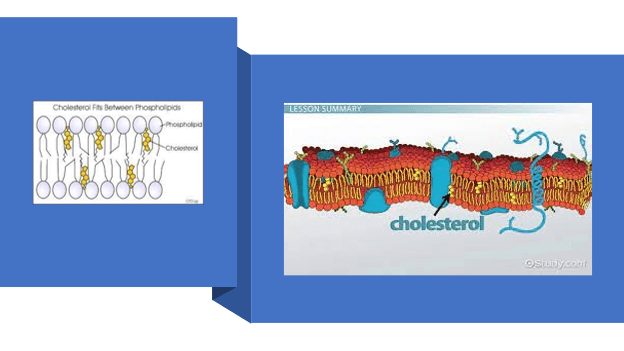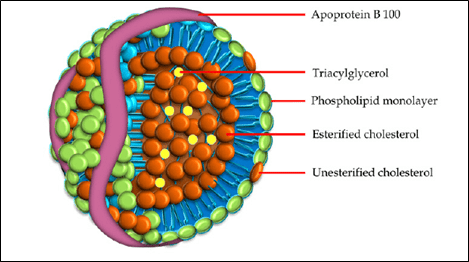Thru a Zen lens – Another way to look at Cholesterol
Your Nutritional Moment of Zen
A Cholesterol Family Photo Album:

It all starts with a 17-carbon, four ring structure (three 6’s and one 5), add an OH (hydroxyl) group to make it a sterol, then layer on a couple of methyl (CH3) groups to the rings plus the carbon side chain at the top and you’ve got the star of the show – Cholesterol.
As we will see cholesterol wears many precursor hats in humans – An obvious one (above) is as mother to vitamin D, along with several other classes of molecules of varying degrees of fame, fortune and infamy…
- Female sex hormones (estradiol, estrone, progesterone)
- Male sex hormones (androsterone, testosterone)
- Anabolic steroids (think Arnold Schwarzenegger in his bulked-up prime, home run “kings” Sammy Sosa, Mark McGuire, Barry Bonds and disgraced stars of Track & Field – Marion Jones, Ben Carson, and almost every East German athlete)
- Adrenal cortical steroids (aldosterone, cortisone and cortisol)
We would have a tough time digesting fats without cholesterol as it is critical component in the production of various bile acids and salts. It certainly has its fingers in a lot of biological pies.
We have it – Plants don’t
We have it because we need it, and well, plants don’t because they don’t need it.[1] In addition to all the above functions, cholesterol is found heavily embedded in each and every cell membrane of ours and every other animal:

It provides structure and rigidity to our cells akin to what cellulose does for plants. We make all we need. As I have mentioned in other Zen’s, there is zero need for us to obtain any from outside sources, with those outside sources being the consumption of animal this’s and that’s.
What is a poison, and is cholesterol one?
Very often it is a matter of degree.[2] Cholesterol falls into that category. As detailed above, it is indeed pretty essential to our well-being, if not existence, but at some point we can overdue this good thing, at which point it becomes a very bad thing. To make things more complicated (Why not, right?) too little isn’t so good either.
This then begs the question: How do we keep it a plus and avoid it becoming a minus? Not surprisingly it has a lot to do with diet…and, naturally, unnatural drugs (i.e., statins).
HDL vs. LDL – One isn’t always good, and the other isn’t always bad
- HDL: High density lipoprotein – “The good”
- LDL: Low density lipoprotein – “The bad” (Pictured below. Note imbedded cholesterol on the surface and inside)

- LDL – Responsible for moving cholesterol from the liver to the cells[3]
- HDL – Responsible for moving cholesterol from the cells back to the liver (for breakdown and/or recycling)[4]
Both have their place in our lives helping to maintain the right amount of cholesterol in the right place at the right time. Our bodies are very good at managing this as long as we don’t throw a monkey-wrench in the process by eating the wrong stuff (i.e., straying from a whole food, plant-based diet).[5]
My maybe not correct a-ha moment – What’s in a plaque?
We tend to think arterial plaque is composed almost, if not entirely, of cholesterol but that’s not accurate. Not even close! It really is quite the mélange:[6]
- Cholesterol (of course)
- Cellular waste products
- Calcium
- Fibrin
- Phospholipids
- Macrophages
- T-lymphocytes
- Smooth muscle cells
For the longest time I used to think our cholesterol score meant just that – a measure of how much cholesterol was in our blood, all the while ignoring the fact it is called LDL cholesterol or HDL cholesterol. In other words, it is a measure of how many of those LDL / cholesterol combination packages are floating around.
It would seem, then, to make sense that LDL would easily deposit cholesterol on our likely already inflamed / jagged artery walls as LDL is in the business of escorting and then readily dropping off its load. It was never designed to distinguish between the two (blood vessel walls and cell membranes) because…it never had to! There were no double bacon burgers, triple cheese pizzas, or quadruple Starbucks’ lattes around when our genetic make-up was growing up.
HDL, on the other hand, is designed to return cholesterol back to the liver without losing it along the way.
Think “low density” as loosely held, and “high density” as tightly held. Admittedly I have no proof, but it does make for an intriguing theory…1-6
SIDEBAR #1: An unfortunate cholesterol-raising fact – You don’t even have to eat the stuff!
Here’s the key equation: More fat = More cholesterol
Bile is responsible for emulsifying ingested (and not water-soluble by definition) fat so it can travel in the, by and large, aqueous medium that we are. Without it digestion in our small intestine, and ultimate absorption by our cells would be impossible. And guess what – One of the main constituents and building blocks of bile is the “star” of this week’s Zen, yup – cholesterol. So the more fat you eat, the more cholesterol your liver produces. You don’t even have to eat the stuff!
SIDEBAR #2: Another (!) unfortunate fact – Biomarkers – Healthy ones don’t necessarily mean healthy people
The question to keep in mind with biomarkers, all biomarkers, is – Are they indicative of morbidity and mortality (i.e., Is there a relationship between a good reading and increased quality and quantity of life…or vice versa)? All too often there isn’t.
How statins work – And why that is so disconcerting, or at least it should be…
Without even needing to address their myriad of side effects,[7] statins violate the principle of allowing our bodies to decide how much cholesterol to have on hand, where it should be located and when it should be there. (Know that in many post-heart attack situations, there is sufficient potential benefit to overcome the potential risks of statins.)
So, is high (LDL) cholesterol cause for concern in and of itself…or just the canary in the coalmine?

Go with the canary. Sure, a high (LDL) cholesterol score is not a good thing, but of far more importance is what is causing it to be high in the first place. THAT is where you want to put your focus, and more than likely that means less meat, less dairy, fewer eggs, and lest I forget, no oil (or at least a reasonable facsimile thereof).7
Don
“Nutritional Zen Master”
The Wellness Forum Institute

Please review our business at: Google Yelp Facebook
If you’d like to learn more, please visit our Member’s Area to access our subscribed content.
Did you know you can work out and exercise with a trainer at your home, office, hotel room, or anywhere in the world with online personal training?
Like us on Facebook/Connect with us on LinkedIn/Follow us on Twitter
Make sure to forward this to friends and followers!
[1] Plants use the polysaccharide cellulose for structural integrity and their own phytosterols for hormonal activities.
[2] Though sometimes not – Mercury, arsenic, and bleach come to mind. No amount of those is a good thing!
[3] T. Colin Campbell in “The China Study” found healthy and happy residents of counties in China where the average TOTAL cholesterol level was 94 mg/dl – Well over 100 points less than in America (215 mg/dl), As necessary as the stuff is (and it is) apparently not much is more than enough.
[4] Higher and higher levels of HDL are not necessarily better. If you don’t have an excess of cholesterol to get back to the liver, the body, always conserving energy and resources, naturally produces lower levels of HDL.
[5] I am reminded of Shakespeare here regarding the typical American / Western-style diet: “More honored in the breach than the observance.”
[6] Fayad and Fuster, Clinical Imaging of the High-Risk or Vulnerable Atherosclerotic Plaque, Circulation Research, 2001;89:305–316.
[7] https://www.webmd.com/cholesterol-management/side-effects-of-statin-drugs#091e9c5e8025c4f7-2-4
